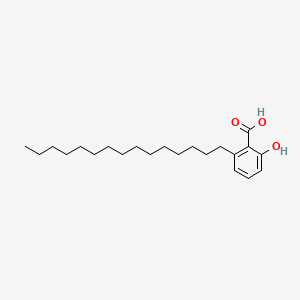| Authors | Title | Published | Journal | PubMed Link |
|---|---|---|---|---|
| Wisastra R et al. | Discovery of a novel activator of 5-lipoxygenase from an anacardic acid derived compound collection. | 2013 | Bioorg. Med. Chem. | pmid:24231650 |
| Wisastra R et al. | Anacardic acid derived salicylates are inhibitors or activators of lipoxygenases. | 2012 | Bioorg. Med. Chem. | pmid:22789707 |
| Wu J et al. | Bisubstrate Inhibitors of the MYST HATs Esa1 and Tip60. | 2009 | Bioorg. Med. Chem. | pmid:19114310 |
| Muroi H et al. | Synergistic effects of anacardic acids and methicillin against methicillin resistant Staphylococcus aureus. | 2004 | Bioorg. Med. Chem. | pmid:14738968 |
| Green IR et al. | Molecular design of anti-MRSA agents based on the anacardic acid scaffold. | 2007 | Bioorg. Med. Chem. | pmid:17601740 |
| Mamidyala SK et al. | Efficient synthesis of anacardic acid analogues and their antibacterial activities. | 2013 | Bioorg. Med. Chem. Lett. | pmid:23416004 |
| Kanojia RM et al. | 6-oxa isosteres of anacardic acids as potent inhibitors of bacterial histidine protein kinase (HPK)-mediated two-component regulatory systems. | 1999 | Bioorg. Med. Chem. Lett. | pmid:10571153 |
| Hoellein A et al. | Myc-induced SUMOylation is a therapeutic vulnerability for B-cell lymphoma. | 2014 | Blood | pmid:25143484 |
| Sung B et al. | Anacardic acid (6-nonadecyl salicylic acid), an inhibitor of histone acetyltransferase, suppresses expression of nuclear factor-kappaB-regulated gene products involved in cell survival, proliferation, invasion, and inflammation through inhibition of the inhibitory subunit of nuclear factor-kappaBalpha kinase, leading to potentiation of apoptosis. | 2008 | Blood | pmid:18349320 |
| Park M et al. | Anacardic acid inhibits pancreatic cancer cell growth, and potentiates chemotherapeutic effect by Chmp1A - ATM - p53 signaling pathway. | 2018 | BMC Complement Altern Med | pmid:29463243 |
ANACARDIC ACID
ANACARDIC ACID is a lipid of Polyketides (PK) class.
